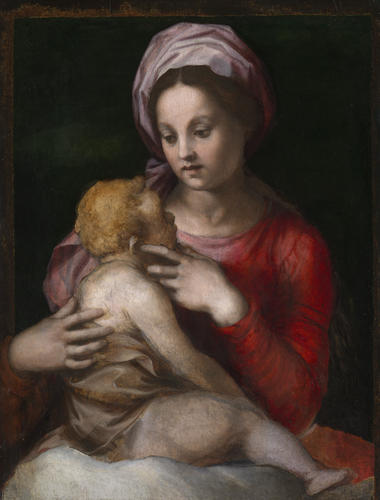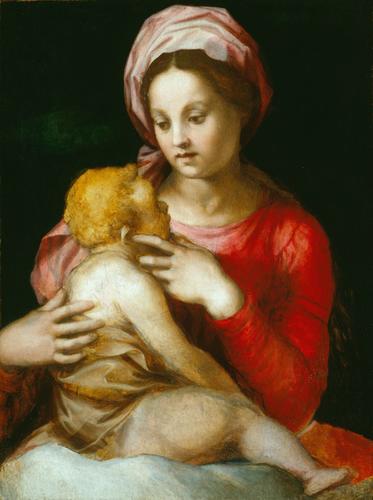-
1 of 253523 objects
The Virgin and Child c. 1528-30
Oil on panel | 56.4 x 42.7 cm (support, canvas/panel/stretcher external) | RCIN 405769
-
The painting must have been a devotional image intended for a domestic setting. It has a natural directness as the Virgin seems to be firmly but gently holding down the Christ Child’s lower lip and searching for signs of teeth. The painting is one of at least four surviving versions of similar size, all of which seem to have been painted at the same time by Andrea del Sarto and his workshop. There are other versions at Alnwick Castle, Northumberland; in the Allen Memorial Art Museum, Oberlin, Ohio; and the so-called ‘Botti Madonna’ in a private collection. This last is of particular interest because it once formed part of the Royal Collection. Named after one of its earliest owners, Matteo Botti, it later belonged to the Grand Duke Cosimo II de’ Medici and Charles I; it was acquired at the Commonwealth Sale by Luis de Haro, principal minister of King Philip IV of Spain.
It has become clear from recent analysis of multiple versions that it was Sarto’s practice to reuse and rework cartoons of successful designs, each version produced by the artist himself. Ideas were first worked out on paper, resulting in a full-scale drawn design or cartoon that could be used to transfer the image on to the surface of the painting and replicate the design. The design could then be adjusted and improved with further studies and with underdrawing on the surface of the painting, so that each version is unique and subject to Sarto’s artistic control. In this painting there is a large amount of exploratory work in the underdrawing on the panel, probably executed freehand with a brush with great confidence and fluidity. In the underdrawing the folds of Christ’s tunic radiate in the opposite direction to the eventual folds. He seems to have been seated cross-legged, his leg then extended out in paint. His right arm was closer to the Virgin’s arm, with his right hand resting on his knee rather than, as now, tucked behind his leg. Many areas were altered when it came to painting.
The order of the four versions and the relationship between them is not clear, although this painting seems to have been the starting point. Recent conservation shows that while the Virgin’s face and headdress were resolved, other areas, particularly the lower part of the painting, were left sketchy, probably unfinished. Narrow strips of wood were added at a later date to expand the composition very slightly on both sides and at the top. Unlike the other versions, the Botti Madonna is slightly smaller (about 10 per cent), meaning that the cartoon would have had to be scaled down. It is painted with more opaque lead whites and has a sketchy and abbreviated character compared with areas of the sculptural density of the Royal Collection version. Both have the extraordinary effect of unfinish, characteristic of late Sarto, seen especially in the Christ Child’s hair. A red chalk study of the Christ Child (Ashmolean Museum, Oxford) is probably by Francesco Salviati, who was working in Andrea del Sarto's studio 1529-30. The painting can be dated by comparison with the Virgin and Child of c. 1528-30 (Pitti Palace, Florence) and the Holy Family of c. 1528-9 (Galleria Nazionale d'Arte Antica, Rome). The background of subtle green is like that behind the Portrait of a Woman Holding a Volume of Petrarch of c. 1528 (Uffizi).
Catalogue entry adapted from The Art of Italy in the Royal Collection: Renaissance and Baroque, London, 2007Provenance
Possibly the 'Madonna of Andrea del Sarto' acquired in 1660 for £25 by Charles II from William Frizell in Breda (List II no 32); conceivably the 'Titian, Madonna and Child, unfinished 1ft 10in x 1ft 5in' recorded in Store at Whitehall in 1666 (no 579); more confidently identified in the Audience Chamber at Hampton Court in 1835 as Andrea del Sarto (no 117)
-
Creator(s)
-
Medium and techniques
Oil on panel
Measurements
56.4 x 42.7 cm (support, canvas/panel/stretcher external)
70.0 x 55.9 x 3.3 cm (frame, external)
Category
Object type(s)
Subject(s)

